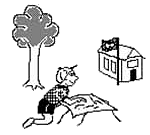 | |||||
| About Us | Contact Us | Services | Copyright | |||||
|
|||||
|
Using Maps By Marilyn Fraser
MapsDifferent maps supply different kinds of information. Most people have a road map that can be had from many service stations and convenience stores for example. These maps give information on the provincial and state roads, on the location of towns and cities, and the distances. Unless you will be travelling some distance by car, these maps will not be a help to you for rockhounding. You might want to make an enlarged photocopy of only the part of the map for your location.
A mineralogical map indicates the minerals that are common in the area covered by the map. Different colours represent different minerals. The Ontario government also has a mineralogical highway map. I think it is free. This is useful for rockhounds. A topographical map is the most useful map for field trips, hiking, camping, and canoeing. These maps give information in great detail. They are usual drawn at 2 centimetres equals one kilometre (or one inch equalling one mile). They use a standard method of signs and symbols that are explained in a legend on one corner of the map. You should buy the map for the district where you will be field tripping. The first thing you should do is study the legend so you will have a better understanding of the map. Different kinds of roads are shown by different kinds of lines. For example, a double heavy line in red indicates a two-lane highway, while a dashed line is only a cart track and a dotted line is a trail or portage. Because of the scale, you can measure the distance on the map with a rule and figure out the distance between two places. Railway tracks, stations, bridges, and tunnels are shown. Churches and schools are shown by pictographs (a symbolic picture which stands for the real thing). Even wells, windmills and lighthouses as well as dwellings are shown in the correct place. You can take the whole map with you on your trip or just photocopy the part that especially interests you. Since the scale is so large and detailed the map only covers one particular district. This is a very good map to keep you from getting lost. Contour LinesContour lines are drawn on the topographical map through all the points that have the same elevation (the same height above sea level). They show the height of the ground above sea level in feet or metres. If the lines are very close together, it would show a steep slope or steep hill, but when farther apart the rise would be more gradual. In this way the map reader can determine the hills and valleys in the area. Looking at the map with an idea of going from, for example the east to the west, and you see a series of lines very close together, you should understand that a very steep climb would be in your way.BearingsA protractor from your geometry set is used for measuring directions or bearing on a map. If a bearing is required from a cross roads to a school (for example), draw a line on the map between the cross roads and the school. Place your protractor along any N-S line on the map's grid, with the centre of the protractor ON the pencil line between the cross road and the school. Then read the bearing on the protractor. The bearing is the pencil line you drew. If it is less than 180 degrees, read the outer scale. If it is between 180 and 360 degrees, read the inner scale on the protractor. Now you follow that direction with your compass. [See using your watch for a compass.]Map ReferencesWhen using a map reference, always measure OVER to the EAST and then UP to the NORTH. In other words find the EASTING and then the NORTHING. If the reference is an easting of 916 and a northing of 944 the reference is indicated as 916944. The letters of the large square concerned should be included.OrientationWhen you know your position on the map and can identify the position of a distant object, such as a church or school, the map can be turned around so that it lines up with the surroundings.How to Order MapsMaps can be ordered, in English or French, and a brochure explaining map reading in greater detail, from:
Canada Map Office Ask for the brochure "How to Use a Map". They also have catalogues of maps, lists of dealers for maps and other information.
This article may not be copied, distributed or reprinted in any form without the author's permission. To contact the author, please use the e-mail address provided. If you are unable to contact the author, please contact the Canadian Rockhound. Authorized reprints must acknowledge the author, original source and the Canadian Rockhound, and include the website URL address of the Canadian Rockhound.
|
||||

Copyright © 2000 Canadian Rockhound
Magazine Issues |
News & Events |
Junior Rockhound |
Resources
|
||||
